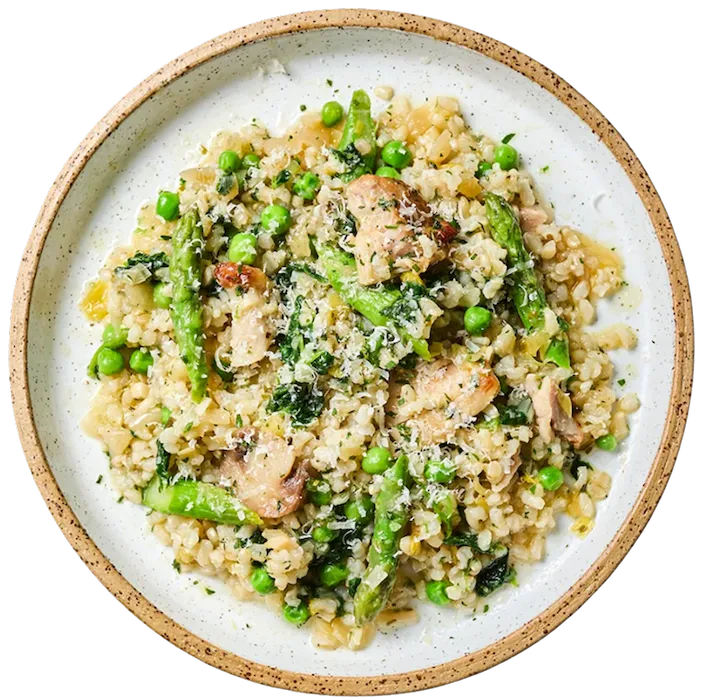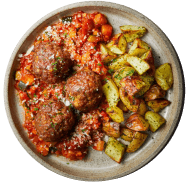Herb Uses And Health Benefits
What Herbs Have Health Benefits, And What Are They?
From spring onions to basil to coriander, herbs do more than flavour food. Explore their science-backed health benefits here, alongside how to use them in your cooking.
Cooking with Herbs and their nutritional benefits.
Herbs help add depth, complexity and lively fresh flavours and textures to dishes, which can help reduce the need for extra salt and sugar making meals healthier and more flavourful.
Many herbs are a great source of polyphenols; naturally occurring compounds found in plants which have antioxidant and anti-inflammatory effects. Polyphenols have prebiotic effects too, which means they feed the beneficial microbes in your gut.
Herbs (both fresh and dried) are also a great way to add more plant-diversity to your diet, counting towards your ‘30 plant points’ a week.
Herbs can be used in a variety of dishes, from salads and soups to main courses and desserts, making them an indispensable part of any kitchen and can help introduce you to new cuisines and flavours.
Use them abundantly in salads and just before serving, but chop herbs gently to avoid bruising, which can lead to bitterness, using a sharp knife or herb scissors. The size of the chopped or sliced herb pieces can affect the dish. Finely chop herbs for smoother textures (like in sauces), and roughly chop for more texture and visual appeal (like in salads).
It’s worth noting that herbs can be separated into hard herbs, like thyme, rosemary, bay, lime leaf or lemon grass that are a bit more robust and less fragile, and they are best used early in cooking finely chopped or used whole and removed. Soft herbs such as coriander, parsley, basil and chives can be used either whole as a leaf or finely chopped but need to be chopped more carefully and are best added at the end of cooking. They are also a great introduction to culinary gardening and grow well in pots or in the ground.
Spring Onion
Spring onions have a mild onion flavour and are versatile and can be used in salads, soups, stir-fries, and as garnishes, as they can be used both raw and after being briefly cooked. They can be both sliced thinly to eat raw and cut into short lengths or even left whole to be cooked. The green part of spring onion is low in FODMAPS, so it’s suitable for those following a low FODMAP diet, so can be a great way to add onion flavour. Spring onions are also a source of vitamin C, which supports the normal functioning of your immune system.
Chives
Chives have a delicate onion-like flavour with a hint of garlic, making them perfect for adding a subtle kick to dishes without overpowering other flavours. They are excellent in dips, soups, salads, and as a garnish. Their purple flowers add a lovely burst of colour. They are safe for those following a low FODMAP diet, so can be a great way to add onion and garlic flavour.
Basil (Green, Purple, or Thai Basil)
Each type of basil offers a unique flavour profile. Green basil is sweet and peppery, purple basil has a slightly spicier and more robust flavour, and Thai basil adds a licourice-like taste. Basil doesn’t like to be stored in the fridge and should be used quickly. Include basil in your meals for extra plant points and polyphenols.
Mint
Mint adds a refreshing, cool flavour to both sweet and savoury dishes. It is widely used in beverages, desserts, salads, and marinades, although some varieties have tougher leaves that are better thinly sliced than whole.Traditionally mint has been used to relieve a range of digestive discomforts, and peppermint oil(which contains the active ingredient menthol) can help relieve cramps in irritable bowel syndrome.
Coriander
Coriander leaves have a distinctive citrusy and slightly peppery flavour that enhances the taste of salsas, curries, salads, and soups. You can use stalks of coriander too, finely chopping and adding to dishes to be cooked or used raw. Coriander is a source of vitamin K, and like other herbs has antioxidant and antimicrobial properties.
Lime Leaf
Lime leaves, often used in Southeast Asian cuisine, impart a unique citrusy and floral aroma to dishes. They are commonly used in Thai curries, soups, and stir-fries. Use whole removing before eating, or thinly sliced after removing the stem.In traditional medicine, lime leaves were used to support healthy teeth and gums, potentially thanks to their anti-microbial properties that prevent the growth of bacteria which cause tooth decay.
Lemongrass
Lemongrass adds a bright, lemony flavour with a hint of ginger, making it a popular ingredient in Thai, Vietnamese, and other Southeast Asian cuisines. It is excellent in soups, curries, and marinades. Use whole removing before eating, or finely chopped after removing tougher outer layers and the base. Lemongrass is rich in a group of polyphenols called flavonoids, which have antioxidant and anti-inflammatory properties.
related content
more content: Nutrients
browse our ranges.
choose from one of our ranges or personalise your own menu from 60+ meals.
- low FODMAP

- eat well, live well programme

- gluten free

- high protein

- weight management

- ibs

- lowest calorie

- lower carbs

- mediterranean

- smaller range

- pcos

- lean + lighter

- menopause

- heart healthy

- full menu

- gift cards